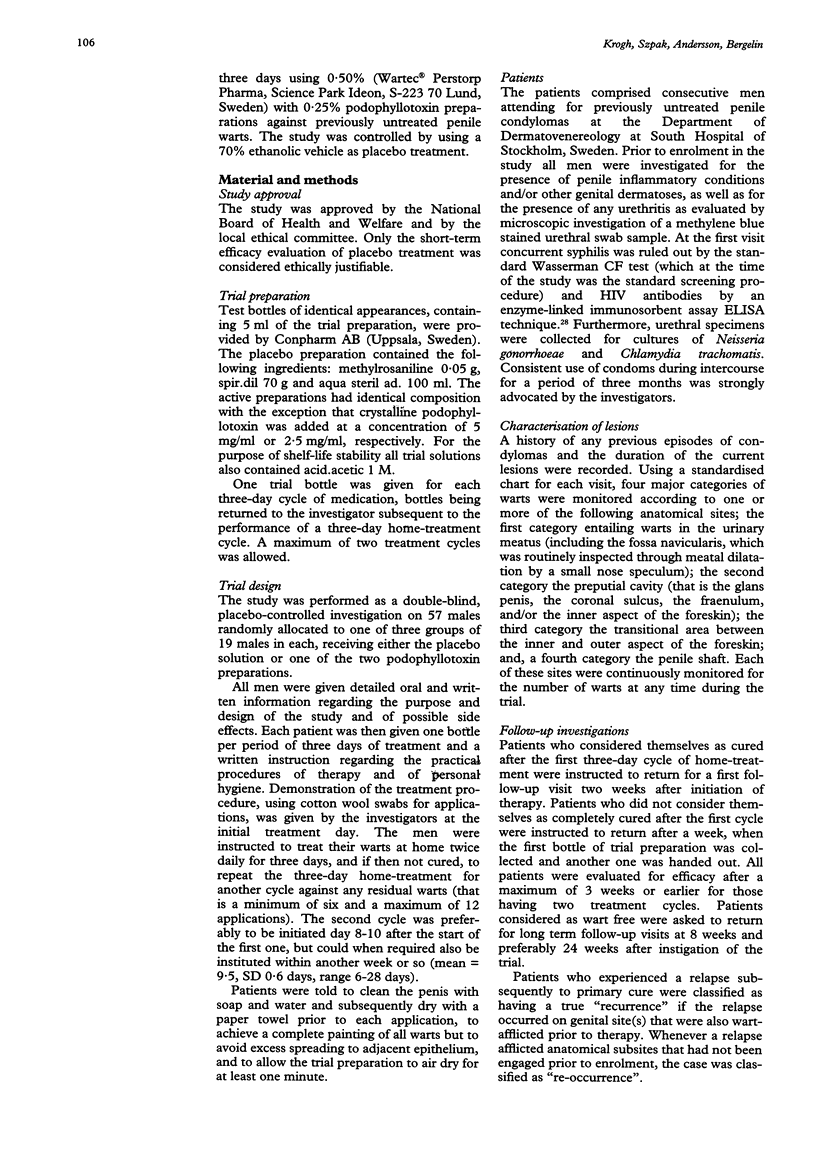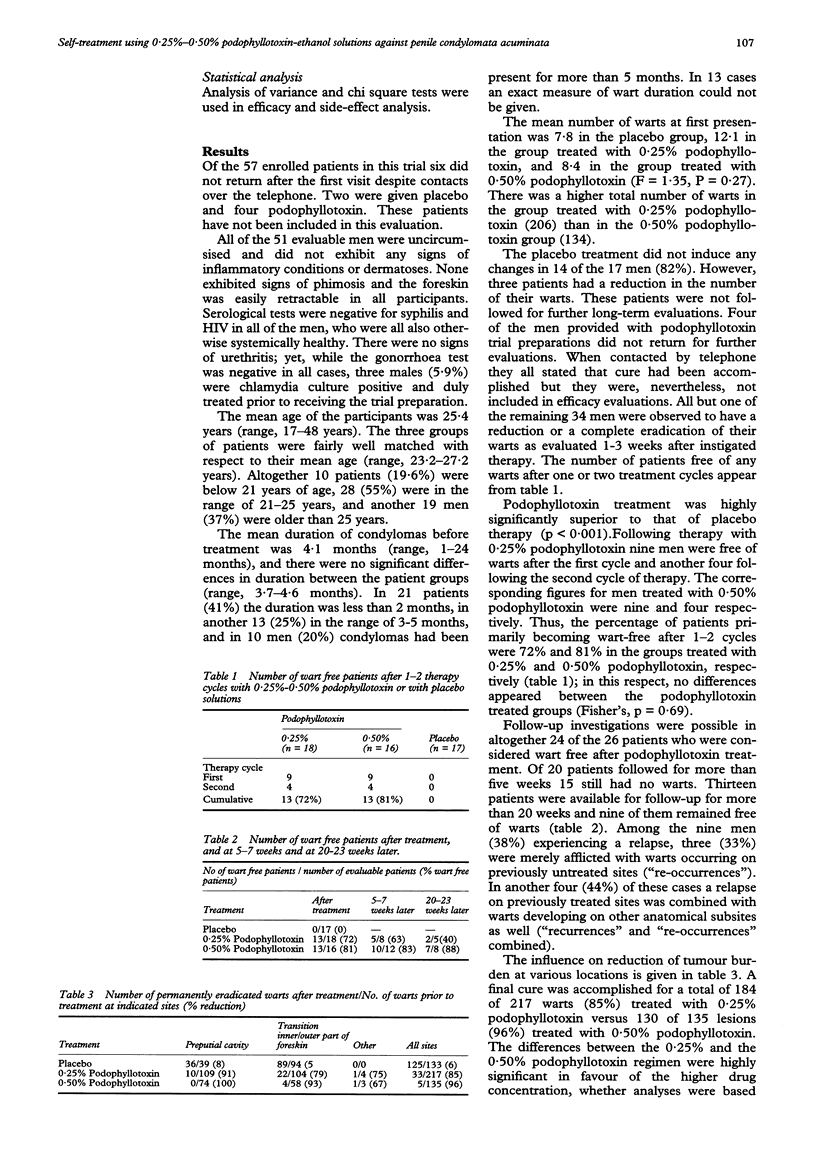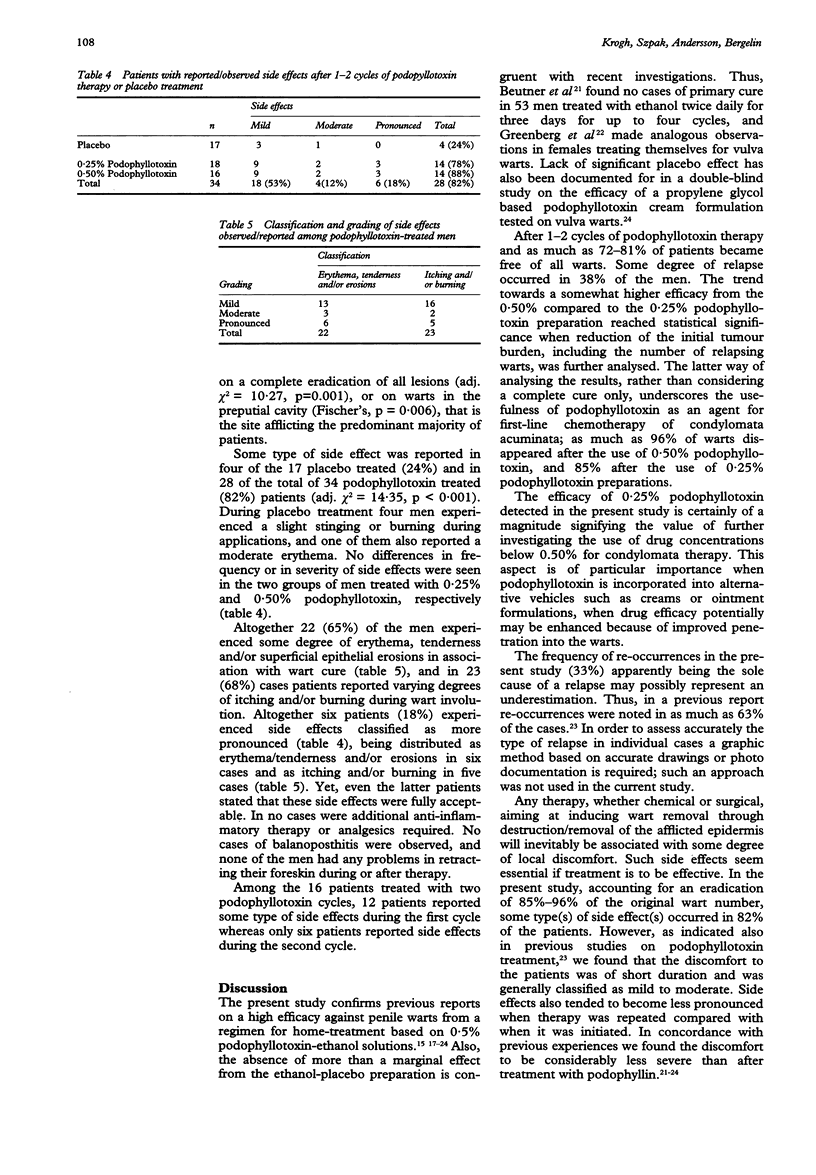Abstract
OBJECTIVE--To compare the efficacy of 0.50% and 0.25% podophyllotoxin preparations against previously untreated penile warts. DESIGN--The study was performed as a double-blind, placebo-controlled investigation on 57 males randomly allocated to one of three groups of 19 males in each, receiving either the placebo solution (70% ethanolic vehicle) or one of the two podophyllotoxin preparations for 1-2 self-treatment courses b.i.d. for three days, separated by a one-week drug-free interval. SETTING--The STD out-patient clinic of the Department of Dermatovenereology at Southern Hospital of Stockholm, Sweden. RESULT--The placebo solution merely exerted a marginal influence on the warts while a primary cure was documented in 72% (13/18) and 81% (13/16) of altogether 34 evaluable men who treated their warts with 0.25% and 0.50% podophyllotoxin, respectively. Follow-up investigation (range 5-23 weeks) was possible for 24 of 26 podophyllotoxin treated men who were primarily cured. Some degree of relapse occurred in nine of them (38%). Of these relapses, warts occurred on previously untreated sites only in three cases (33%), and in another four (44%) relapse was associated with regrowth on treated sites as well as on new sites. When analysing the debulking potential of podophyllotoxin, it appeared that 0.25% podophyllotoxin eradicated 184 of originally 217 warts (85%); the corresponding figure for 0.50% podophyllotoxin was as high as 130 of 135 lesions (96%). Side effects were generally mild-moderate and well tolerated. CONCLUSION--The results underscore the potential usefulness of low-dose podophyllotoxin preparations as first-line chemotherapy of condylomata acuminata for home-treatment. The efficacy from topical use of 0.25% podophyllotoxin detected in the study is certainly of a magnitude signifying that podophyllotoxin concentrations lower than 0.50% deserve further investigation if the drug may be incorporated into alternative vehicles such as creams or ointments.
Full text
PDF




Selected References
These references are in PubMed. This may not be the complete list of references from this article.
- Beutner K. R., Conant M. A., Friedman-Kien A. E., Illeman M., Artman N. N., Thisted R. A., King D. H. Patient-applied podofilox for treatment of genital warts. Lancet. 1989 Apr 15;1(8642):831–834. doi: 10.1016/s0140-6736(89)92282-4. [DOI] [PubMed] [Google Scholar]
- Beutner K. R., von Krogh G. Current status of podophyllotoxin for the treatment of genital warts. Semin Dermatol. 1990 Jun;9(2):148–151. [PubMed] [Google Scholar]
- Culp O. S., Kaplan I. W. Condylomata Acuminata: Two Hundred Cases Treated With Podophyllin. Ann Surg. 1944 Aug;120(2):251–256. doi: 10.1097/00000658-194408000-00012. [DOI] [PMC free article] [PubMed] [Google Scholar]
- Greenberg M. D., Rutledge L. H., Reid R., Berman N. R., Precop S. L., Elswick R. K., Jr A double-blind, randomized trial of 0.5% podofilox and placebo for the treatment of genital warts in women. Obstet Gynecol. 1991 May;77(5):735–739. [PubMed] [Google Scholar]
- KELLY M., HARTWELL J. L. The biological effects and the chemical composition of podophyllin: a review. J Natl Cancer Inst. 1954 Feb;14(4):967–1010. [PubMed] [Google Scholar]
- Kinghorn G. R., McMillan A., Mulcahy F., Drake S., Lacey C., Bingham J. S. An open, comparative, study of the efficacy of 0.5% podophyllotoxin lotion and 25% podophyllotoxin solution in the treatment of condylomata acuminata in males and females. Int J STD AIDS. 1993 Jul-Aug;4(4):194–199. doi: 10.1177/095646249300400403. [DOI] [PubMed] [Google Scholar]
- Lassus A. Comparison of podophyllotoxin and podophyllin in treatment of genital warts. Lancet. 1987 Aug 29;2(8557):512–513. doi: 10.1016/s0140-6736(87)91823-x. [DOI] [PubMed] [Google Scholar]
- Loike J. D., Horwitz S. B. Effects of podophyllotoxin and VP-16-213 on microtubule assembly in vitro and nucleoside transport in HeLa cells. Biochemistry. 1976 Dec 14;15(25):5435–5443. doi: 10.1021/bi00670a003. [DOI] [PubMed] [Google Scholar]
- Mazurkiewicz W., Jablonska S. Vergleichende Untersuchungen zwischen 0.5% Podophyllotoxin-Präparaten (Condyline) und 20% Podophyllin, gelöst in Alkohol, bei der Therapie von spitzen Kondylomen. Z Hautkr. 1986 Oct 1;61(19):1387–1395. [PubMed] [Google Scholar]
- Reid R., Greenberg M. D., Lörincz A. T., Daoud Y., Pizzuti D., Stoler M. Superficial laser vulvectomy. IV. Extended laser vaporization and adjunctive 5-fluorouracil therapy of human papillomavirus-associated vulvar disease. Obstet Gynecol. 1990 Sep;76(3 Pt 1):439–448. [PubMed] [Google Scholar]
- Simmons P. D. Podophyllin 10% and 25% in the treatment of ano-genital warts. A comparative double-blind study. Br J Vener Dis. 1981 Jun;57(3):208–209. doi: 10.1136/sti.57.3.208. [DOI] [PMC free article] [PubMed] [Google Scholar]
- von Krogh G. Clinical relevance and evaluation of genitoanal papilloma virus infection in the male. Semin Dermatol. 1992 Sep;11(3):229–240. [PubMed] [Google Scholar]
- von Krogh G. Genitoanal papillomavirus infection: diagnostic and therapeutic objectives in the light of current epidemiological observations. Int J STD AIDS. 1991 Nov-Dec;2(6):391–404. doi: 10.1177/095646249100200601. [DOI] [PubMed] [Google Scholar]
- von Krogh G., Hellberg D. Self-treatment using a 0.5% podophyllotoxin cream of external genital condylomata acuminata in women. A placebo-controlled, double-blind study. Sex Transm Dis. 1992 May-Jun;19(3):170–174. doi: 10.1097/00007435-199205000-00012. [DOI] [PubMed] [Google Scholar]
- von Krogh G., Maibach H. I. Cutaneous cytodestructive potency of lignans. I. A comparative evaluation of influence on epidermal and dermal DNA synthesis and on dermal microcirculation in the hairless mouse. Arch Dermatol Res. 1982;274(1-2):9–20. doi: 10.1007/BF00510353. [DOI] [PubMed] [Google Scholar]
- von Krogh G., Maibach H. I. Cutaneous cytodestructive potency of lignans. II. A comparative evaluation of macroscopic-toxic influence on rabbit skin subsequent to repeated 10-day applications. Dermatologica. 1983;167(2):70–77. [PubMed] [Google Scholar]
- von Krogh G. Podophyllotoxin in serum: absorption subsequent to three-day repeated applications of a 0.5% ethanolic preparation on condylomata acuminata. Sex Transm Dis. 1982 Jan-Mar;9(1):26–33. [PubMed] [Google Scholar]
- von Krogh G. Topical treatment of penile condylomata acuminata with podophyllin, podophyllotoxin and colchicine. A comparative study. Acta Derm Venereol. 1978;58(2):163–168. [PubMed] [Google Scholar]


